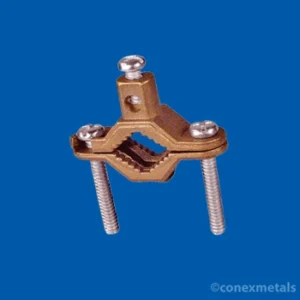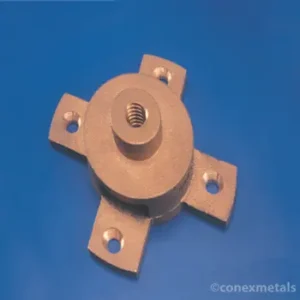Rain Water Pipe RWP Bonds
Rain Water Pipe RWP Bonds
| Rain Water Pipe RWP Bonds | |||
|---|---|---|---|
| Maximum Tape Width (mm) | Bolt Size | Conductor Material | Weight Each (kg) |
| 26 | M10 | Copper | 0.12 |
| 26 | M10 | Aluminium | 0.07g |
 Rain Water Pipe (RWP) bonds, also known as rainwater downpipe bonds or gutter bonds, are electrical connections used to provide effective grounding for rainwater pipes or gutters. They are an important component of lightning protection and earthing systems, ensuring the safe dissipation of lightning currents and preventing electrical hazards that may arise due to lightning strikes on the building’s rainwater pipes.
Rain Water Pipe (RWP) bonds, also known as rainwater downpipe bonds or gutter bonds, are electrical connections used to provide effective grounding for rainwater pipes or gutters. They are an important component of lightning protection and earthing systems, ensuring the safe dissipation of lightning currents and preventing electrical hazards that may arise due to lightning strikes on the building’s rainwater pipes.
Key features and uses of RWP bonds include:
- Electrical Safety: RWP bonds are designed to safely direct lightning currents away from rainwater pipes and gutters, reducing the risk of structural damage and electrical hazards.
- Lightning Protection: In a lightning protection system, RWP bonds help to create a low-resistance path for lightning currents to travel safely to the grounding system, which disperses the electrical energy into the ground.
- Material: RWP bonds are typically made from high-conductivity materials like Copper or tinned Copper, as these materials provide excellent electrical conductivity and corrosion resistance.
- Connection: RWP bonds are securely attached to the rainwater pipes and then connected to the building’s main grounding system, ensuring a reliable and continuous path for lightning current.
- Compliance: RWP bonds are installed according to recognized industry standards and local electrical codes to ensure compliance with safety requirements.
- Inspection and Maintenance: Regular inspection and maintenance of RWP bonds are essential to ensure their ongoing effectiveness and integrity. Damaged or corroded bonds should be promptly repaired or replaced.
Rainwater pipes and gutters are often located on the exterior of buildings and are susceptible to being struck by lightning during thunderstorms. Without proper grounding, a lightning strike on a rainwater pipe could lead to electrical damage, fires, or structural issues.





